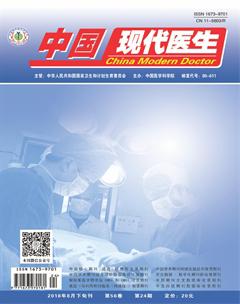IL—10启动子区—1082基因多态性与脓毒血症易感性的关系研究
王蕾 谢月群 陈玲珑 陈新国 张和
[摘要] 目的 分析脓毒血症患者IL-10的启动子区域转录起始位点上游第1082位点的多态性,探讨其与脓毒血症易感性之间的关系。 方法 采用聚合酶链反应-限制性片段多态性(PCR-RELP)检测IL-10基因-1082位点多态性,SPSS17.0分析各位点的基因型分布和等位基因频率。 结果 IL-10-1082位点的多态性在脓毒血症组(AA:58.16%、GA:39.80%、GG:2.04%)与对照组(AA:73.75%、GA:26.25%)的基因频率有显著性差异(P<0.05)。脓毒血症组中GA基因型的频率显著高于对照组(P=0.038),脓毒血症组中G等位基因的频率显著高于对照组(P=0.015)。结论 IL-10-1082 GA基因型携带者比AA基因型患者的脓毒血症风险性高,IL-10-1082的G等位基因比A等位基因患脓毒血症的风险性高。
[关键词] 脓毒血症;疾病遗传易感性;白细胞介素10;多态性
[中图分类号] R459.7 [文献标识码] A [文章编号] 1673-9701(2018)24-0001-03
Study on the relationship between locus 1082 gene polymorphism in IL-10 promoter region and susceptibility to sepsis
WANG Lei1 XIE Yuequn1 CHEN Linglong1 CHEN Xinguo1 ZHANG He2
1.Department of Emergency, Wenzhou Peoples Hospital in Zhejiang, Wenzhou 325000, China; 2.Department of Radiotherapy, Wenzhou Central Hospital in Zhejiang, Wenzhou 325000, China
[Abstract] Objective To analyze the polymorphism at locus 1082 in the upstream of the transcriptional start site in the promoter region of IL-10 in sepsis patients, and to explore its relationship with susceptibility to sepsis. Methods Polymerase chain reaction-restriction fragment polymorphism(PCR-RELP) was used to detect the IL-10-1082 polymorphism. SPSS 17.0 was used to analyze the genotypic distribution and allele frequencies at each locus. Results The gene frequency of polymorphism of IL-10-1082 in the sepsis group(AA: 58.16%, GA: 39.80%, GG: 2.04%) and the control group(AA: 73.75%, GA: 26.25%) had significant differences(P<0.05). The frequency of GA genotypes in the sepsis group was significantly higher than that in the control group(P=0.038). The frequency of G allele in the sepsis group was significantly higher than that in the control group(P=0.015). Conclusion IL-10 -1082 GA genotype carriers have a higher risk of sepsis than those with AA genotypes. The G-10 allele of IL-10-1082 has a higher risk of sepsis than the A allele.
[Key words] Sepsis; Disease genetic predisposition; IL-10; Polymorphism
膿毒血症是当今危重症医学的研究焦点和棘手问题。在全世界,脓毒血症每年的病死率高达36800例,其死亡率与心肌梗死相近,已成为老年人十大死因之一[1]。近年来众多研究者正在研究脓毒血症的易感因素。脓毒血症是一种常见危重症患者较为严重的感染性、多器官损伤疾病,多种炎症介质参与其发生与发展过程,期间分泌大量炎症细胞因子[2]。IL-10基因定位于1号染色体q31-32区域[3],-1082 G/A(rs18 00896)为其基因多态性之一。有研究显示白细胞介素10(Interleukin-10,IL-10)启动子区的基因多态性能够影响IL-10的启动子活性,进而调节IL-10的表达[4-6]。IL-10是重要的抗炎症的细胞因子,IL-10通过Th1细胞机制调节免疫应答,拮抗促炎症细胞因子如TNF-α,从而促进脓毒血症的发生[7]。此外,IL-10在类风湿关节炎、病毒性心肌炎的发生与发展中也扮演着重要的角色,其通过抑制炎症反应,从而促进疾病的发生与发展[8]。研究显示,与IL-18及肿瘤坏死因子-α相比,IL-10对老年脓毒血症患者的预后预测价值更佳[8]。然而IL-10-1082的基因多态性对脓毒血症发生的易感性至今还不明确,本文采用 PCR 限制性酶切多态性(PCR-RFLP)的方法研究 IL-10 的基因启动子区-1082位点的多态性与脓毒血症发生的关系,旨在探讨其对脓毒血症易感性的影响,为脓毒血症的预防研究提供科学基础。
1 对象与方法
1.1 研究对象
本研究收集2016年1月~2017 年9月于我院住院并确诊的脓毒血症患者98例,诊断依据“2001年危重病医学会/欧洲危重病医学会/美国胸科医师协会/外科感染学会关于全身性感染的定义会议”诊断标准[9]。健康对照组选自2017年1~9月在温州市人民医院体检健康的80名志愿者,最大年龄90岁,最小年龄37岁,中位年龄61 岁。脓毒血症组最大年龄86岁,最小年龄27岁,中位年龄65岁。
1.2 方法
1.2.1 DNA模板的制备 取所有受试者静脉血3 mL,EDTA抗凝,用改良碘化钠法提取白细胞DNA,保存在-20°C条件下。
1.2.2 IL-10多态性分析 采用链合酶联反应-限制性片断长度多态性(polymerase chainreaction with restriction fragment length polymorphism,PCR-RFLP)技术,检测IL-10基因启动子区-1082位点的基因型。根据参考文献并应用Primer Premier 5.0来设计引物。IL-10-1082位点的引物序列,正向链: 5‘-GACAACACTACTAAGGCTCCTTTGGGA-3 反向链: 5‘-GTGAGCAAACTGAGGCACAGA AAT-3[10]。扩增条件为55℃ 45 s,72℃ 60 s,94℃ 30 s,共35个循环。PCR 的反应体系为50 μL,包括以下组分:DNA聚合酶1.25 U,上下游引物各1.0 μL,10×buffer 5.0 μL,MgCl2 3.0 μL,dNTPs 3.0 μL,灭菌双蒸水补至50 μL,模板50 ng,则进行下一步酶切实验。取PCR产物10 μL,加Bsl Ⅰ 10 U,10×NEBuffer3 3.0 μL,灭菌双蒸水补至30 μL,水浴55℃ 2 h,酶切后于3%的琼脂糖凝胶上电泳,鉴定结果。
1.2.3 IL-10 -1082位点PCR扩增及酶切分析 IL-10-1082位点的PCR产物经BslⅠ酶切电泳后产生278 bp及37 bp 2 个片段为 AA型,产生278 bp、253 bp、37 bp、25 bp 4个片段为GA型,253 bp、37 bp、25 bp 3个片段为GG型。
1.3 统计学方法
采用 SPSS17.0软件进行统计处理,各组IL-10-1082位点基因型及等位基因频率比较,其分布符合Hardy-Weinberg平衡规律,说明本实验人群具有群体代表性,该人群的IL-10基因分布可反映整体人群基因的分布情况。计数资料以[n(%)]表示,采用χ2检验,并计算比数比(OR),进行相关性分析,以P<0.05 为差异有统计学意义。
2 结果
2.1 样本基本情况
脓毒血症组与对照组在性别、年龄及吸烟情况比较无显著性差异(P>0.05)。见表1。
2.2 IL-10-1082各基因型分布与脓毒血症相对风险分析
IL-10-1082的基因分型和等位基因频率与脓毒血症易感性的关系中,脓毒血症组IL-10-1082位点GA基因型分布频率显著高于对照组(OR=2.018,95%CI:1.053~3.868,P=0.038),对照组中未检测到 IL-10-1082GG基因型,等位基因分析结果显示脓毒血症组G等位基因分布频率显著高于对照组(OR=2.014,95%CI:1.168~3.473,P=0.015)。见表2。
3 讨论
IL-10是公认的炎症抑制因子,主要是由Th2细胞、巨噬细胞、单核细胞及基质细胞等分泌,它的主要功能是抑制Th1细胞,是调节促炎细胞因子的重要的抗炎症细胞因子,如肿瘤坏死因子TNF-α及一氧化氮的合成,炎症细胞的凋亡和巨噬细胞活化的抑制等[11-12]。在人类中,血循环中IL-10水平升高与脓毒血症性休克、损伤的严重性以及死亡率相关。人类IL-10基因包含5个外显子和4个内含子,位于1号染色体q31-32区域,IL-10的表达可受转录水平[13-14]和转录后水平[15-16]的调节,研究表明,IL-10主要是受转录水平调控,且IL-10分泌很大程度上受到遗传因素的影响[17],其转录起始位点上游5 kb的区域内,至少有23个单核苷酸多态性(SNP)位点,其中研究最多的是启动子上游第1082位点(G/A)SNP[18]。IL-10基因启动子区特定的SNP可正向或负向影响IL-10的分泌水平[18-19],从而影响对某种特定疾病的易感性。研究表明IL-10基因多态性可能影响肿瘤的易感性与IL-10-1082基因位点等位基因G有关,如子宫颈癌、肺癌等,其影响机制可能与下调IL-1B、TNF-α和血管内皮生长因子的活性有关[20]。在IL-10基因中,-1082位置处的G单核苷酸启动子多态性在IL-10的调节中是重要的。对于G等位基因纯合的个体(-1082 GG)在体外刺激后具有更高的循环IL-10,更高的IL-10 mRNA表达和更高的IL-10产生[21]。
本文研究结果显示两组患者IL-10-1082位点基因型分布频率差异均具有统计学意义(P=0.038),脓毒血症组IL-10-1082 GA 基因型频率高于对照组,相对风险为2.018(1.053~3.868);等位基因分析結果显示脓毒血症组G等位基因分布频率高于对照组,有显著性差异(P=0.015),相对风险为2.014(1.168~3.473),提示-1082 位点G等位基因与脓毒血症的发生有相关性。体内外的研究表明 IL-10-1082 A等位基因的 IL-10 表达较低[18,22,23],而 IL-10-1082 G等位基因的IL-10表达较高[18],这表明-1082位点多态性影响IL-10的表达水平,IL-10作为一种抑制炎症因子,是其促进脓毒血症的发生,是-1082位点与脓毒血症易感性相关的遗传学依据,本研究结果也与之相一致。但有关IL-10-1082基因多态性与脓毒血症发生的相关报告较少,其关系尚不明确,仍有待进一步的深入研究来阐明。
本研究分析IL-10 基因啟动子-1082位点基因多态性,结果显示:IL-10-1082 GA基因型携带者比AA基因型患者的脓毒血症风险性高,IL-10-1082的G等位基因比A等位基因患脓毒血症的风险性高。此研究结果与之前体内外研究数据相一致,为脓毒血症的病因学和遗传学研究提供了有力的实验数据,提示IL-10可作为防治脓毒血症的一个重要靶点。
[参考文献]
[1] Griffiths B,Anderson ID. Sepsis,Sirs and Mods[J]. Surgery(Oxford),2009,27(10):446-449.
[2] 龙涛,李智,白蓉蓉,等. 外周血淋巴细胞亚群检测对脓毒血症患者的预后分析[J]. 中华医院感染学杂志,2015,(14):3125-3126.
[3] Eskdale J,Kube D,Tesch H,et al. Mapping of the human IL10 gene and further characterization,of the 5 flanking sequence[J]. Immunogenetics,1997,46(2):120.
[4] Edwards-Smith CJ,Jonsson JR,Purdie DM,et al. Interleukin-10 promoter polymorphism predicts initial response of chronic hepatitis C to interferon alfa[J]. Hepatology,1999,30(2):526-530.
[5] Lazarus M,Hajeer AH,Turner D,et al. Genetic variation in the interleukin 10 gene promoter and systemic lupus erythematosus[J]. Journal of Rheumatology,1997,24(12):2314-2317.
[6] Crawley E,Kay R,Sillibourne J,et al. Polymorphic haplotypes of the interleukin-10 5' flanking region determine variable interleukin-10 transcription and are associated with particular phenotypes of juvenile rheumatoid arthritis[J]. Arthritis & Rheumatology,1999,42(6):1101-1108.
[7] Couper KN,Blount DG,Riley EM. IL-10:the master regulator of immunity to infection[J]. Journal of Immunology,2008,180(9):5771-5777.
[8] 覃红梅,甘枚,刘柯. 血清白细胞介素-18、-10与肿瘤坏死因子-α在老年脓毒血症患者预后中的预测价值[J].中国老年学,2016,36(12):2993-2994.
[9] Levy MM,Fink MP,Marshall JC,et al. 2001 sccm/esicm/accp/ats/sis international sepsis definitions conference[J]. Intensive Care Medicine,2003,29(4):530-538.
[10] Mohebbatikaljahi H,Menevse S,Yetkin I,et al. Study of interleukin-10 promoter region polymorphisms(-1082A/G,-819T/C and-592A/C)in type 1 diabetes mellitus in Turkish population[J]. Journal of Genetics,2009,88(2):245-248.
[11] Chen YX,Man K,Ling GS,et al. A crucial role for dendritic cell(DC) IL-10 in inhibiting successful DC-based immunotherapy:superior antitumor immunity against hepatocellular carcinoma evoked by DC devoid of IL-10[J]. Journal of Immunology,2007,179(9):6009-6015.
[12] Oberholzer A,Oberholzer C,Moldawer LL. Interleukin-10:A complex role in the pathogenesis of sepsis syndromes and its potential as an anti-inflammatory drug[J]. Critical Care Medicine,2002,30(1):S58-S63.
[13] Brightbill HD,Plevy SE,Modlin RL,et al. A prominent role for Sp1 during lipopolysaccharide-mediated induction of the IL-10 promoter in macrophages[J]. The Journal of Immunology,2000,164(4):1940-1951.
[14] Lobo-Silva D,Carriche GM,Castro AG,et al. Balancing the immune response in the brain: IL-10 and its regulation[J]. Journal of neuroinflammation,2016,13(1):297.
[15] Govender U,Corre B,Bourdache Y,et al. Type I interferon-enhanced IL-10 expression in human CD4 T cells is regulated by STAT3,STAT2,and BATF transcription factors[J]. Journal of Leukocyte Biology,2017,101(5):1181-1190.
[16] Takuse Y,Watanabe M,Inoue N,et al. Association of IL-10-regulating MicroRNAs in peripheral blood mononuclear cells with the pathogenesis of autoimmune thyroid disease[J]. Immunological Investigations,2017,46(6):590-602.
[17] Rosenwasser LJ.Genetics of atopy and asthma. The rationale behind promoter-based candidate gene studies[J]. American Journal of Respiratory & Critical Care Medicine, 1997,156(4 Pt 2):S152-S155.
[18] Turner DM,Williams DM,Sankaran D,et al. An investigation of polymorphism in the interleukin-10 gene promoter[J]. International Journal of Immunogenetics,1997, 24(1):1-8.
[19] Eskdale J,Gallagher G,Verweij CL,et al. Interleukin 10 secretion in relation to human IL-10 locus haplotypes[J]. Proceedings of the National Academy of Sciences of the United States of America,1998,95(16):9465-9470.
[20] 張晓杰,王莹. 儿童溃疡性结肠炎血清IL-1、IL-6、IL-10及TNF-α水平变化[J]. 中国妇幼保健,2015,30(20):3413-3415.
[21] Gallagher PM,Lowe G,Fitzgerald T,et al. Association of IL-10 polymorphism with severity of illness in community acquired pneumonia[J]. Thorax,2003,58(2):154-156.
[22] Rad R,Dossumbekova A,Neu B,et al. Cytokine gene polymorphisms influence mucosal cytokine expression,gastric inflammation,and host specific colonisation during Helicobacter pylori infection[J]. Gut,2004,53(8):1082-1089.
[23] Craven NM,Jackson CW,Kirby B,et al. Cytokine gene polymorphisms in psoriasis[J]. British Journal of Dermatology,2001,144(4):849-853.
(收稿日期:2017-11-24)

